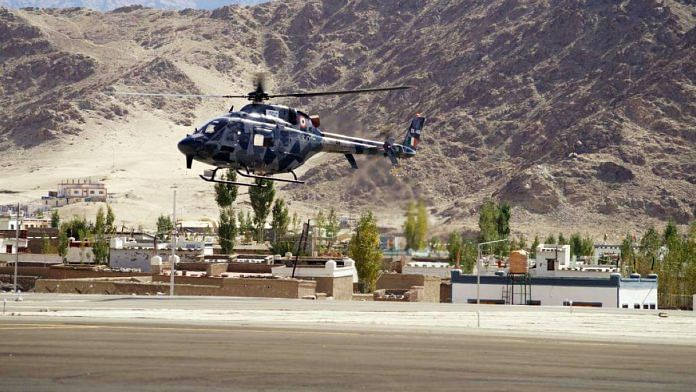New Delhi: The process to replace India’s nearly six-decade-old fleet of Cheetah and Chetak helicopters, whose technical life is nearing an end, will take at least a whole decade, it is learnt.
The Services (Army, Navy and Air Force) while pinning their hopes on the Indian-made Light Utility Helicopter (LUH), which is yet to be fully certified as the replacement for the ageing fleet, are hoping that critical systems on board the LUH — currently being tested — will be certified and a full-fledged order will be placed over the next 18-20 months.
The Army, which has a requirement for about 250 light helicopters for their reconnaissance and smaller load-carrying capabilities, is looking at the option of leasing choppers to meet its immediate requirements. To that effect, the Army is studying responses it received to a Request for Information (RFI) sent out in this regard earlier this year.
Asked why it will take at least 10 years to replace the Cheetah/Chetak fleet, sources in the defence establishment said state-run Hindustan Aeronautics Limited (HAL) can produce around 30 LUH each year, which will then be divided between the three Services.
Given that the technical life of the first few Chetak helicopters will not be more than four years, sources added that the hope is that they will be replaced with new choppers.
The IAF originally inducted the seven-seater French-origin Alouette III helicopters in 1962, followed by the HAL handing over its first licence-produced ‘Chetak’ (Alouette III) to the IAF in 1965. And it was only in 1970 that HAL signed a deal with France to locally produce the five-seater SA-315B Lama helicopters, which were rechristened ‘Cheetah’ when delivered to the IAF in 1976.
The combined strength of Chetak and Cheetah helicopters operated by the three Services is an estimated 400.
Though the first lot to be commissioned is not flying, the majority of the fleet of the 186 Chetak and more than 200 Cheetah helicopters fall in the vintage category, having served for over 40 years and counting.
A diamond jubilee celebration was held at the IAF’s Helicopter Training School in Secunderabad in March last year to mark 60 years since the Chetak helicopters were pressed into service.
But this technology from the 1960s will continue to dominate the skies over the next few decades since the armed forces are still placing orders for them, given the lack of options.
Also Read: As IAF phases out yet another MiG-21 squadron, a look at the journey of the fighter aircraft
The Light Utility Helicopters (LUH) saga
The process to replace the Chetak and Cheetah helicopters has been a protracted one.
It was only in November 2021 that the defence ministry approved the procurement of 12 indigenous Light Utility Helicopters (LUH) from Hindustan Aeronautics (HAL) to replace this ageing fleet. As reported by ThePrint earlier, these 12 new choppers — six each for the Army and IAF — were to be delivered under the scope of a limited series production configuration, starting from August 2022, after which a larger order was to be placed.
However, the helicopters, which Army sources said were better in terms of performance, compared to Cheetah/Chetak, and performed exceptionally well in high-altitude areas, were not fitted with autopilot. This feature, sources explained, is a must for these choppers to be able to fly in high-altitude zones like Siachen, owing to a change in the rotor system.
The LUH has now been fitted with the autopilot feature and is undergoing trials.
ThePrint had highlighted earlier that the Request for Quotation (RFQ) noted that the first LUH should have the AFCS (Automatic Flight Control System). Since the AFCS was yet to be certified, the deliveries of these 12 choppers — expected to take place this fiscal year — now stand delayed. A case for LUH series production will be made only after the delivery of choppers commissioned under the scope of limited series production.
India’s overall demand for light helicopters, meant for transportation of men and supplies to high-altitude areas, besides evacuation and reconnaissance, is estimated to be more than 400. While HAL was expected to meet at least half of the total requirement, Indo-Russian Helicopters Ltd (IRGL), a joint venture of HAL and two Russian firms — Russian Helicopters and Rosoboronexport — was to meet the rest with Kamov Ka-226T choppers.
However, sources confirmed to ThePrint that the Kamov project, which was the Modi government’s first government-to-government deal in 2015, is unlikely to happen.
Sources also said that the Services have adopted a two-pronged approach to replace the Cheetah/Chetak fleet.
There is progress on the induction of light helicopters and the search for alternatives, sources added while underlining that the request for additional light helicopters is being processed since the idea is to achieve an optimum balance of airlift and air strike capability.
Further, the integration of HELINA missiles with ALH-WSI (HAL Rudra) is also said to be in progress.
The modernisation of Army Aviation can be traced back to the induction of multi-engine Dhruv Advanced Light Helicopters (ALH) over two decades ago. This was followed by the induction of armed helicopters in 2013. Comprising modern Advanced Light Helicopter (ALH) Mk-III, Weapon System Integrated (WSI) helicopter and Light Combat Helicopter (LCH), Army Aviation is set to add LUH and Apache Attack helicopters to its fleet.
Given that the first LCH squadron was raised, deployed and operationalised earlier this year, the armed forces are expected to place more orders for Light Combat Helicopters. At the same time, the training of pilots and technicians operating Apache Attack Helicopters is complete and will be followed by the induction of the first three choppers next March.
Moreover, the induction of Remotely Piloted Aircraft System (RPAS) Heron Mk-II and Hermes 900 Starliner are expected to boost the Army’s reconnaissance and surveillance capabilities.
(Edited by Amrtansh Arora)
Also Read: Army successfully test-fires rocket & turret guns of indigenous light combat helicopter Prachand



